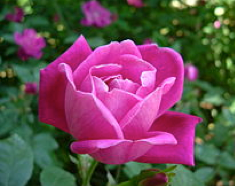Rosa
| Rosa / Mawar | |
| Scientific Name | Rosa chinensis Jacq |
| Family | Rosaceae |
| Common name | ros, China Rose |
 |
{slider=Geographical & Distribution}
China
{/slider}
{slider=General Appearance}
Shrub growing to 1-2 m tall. The leaves are pinnate, have 3-5 leaflets, each leaflet 2.5-6 cm long and 1-3 cm broad. The fowers have pink to red petals. The fruit is a red hip 1-2 cm diameter.Grows in soils ranging from a pH of 4.5 to 8. It is adapted to chalk, clay loam. Loamy sand, sandy clay loam and sandy loam soils, and prefers high fertility. Roses are propagated by seeds, cuttings, layering and grafting.
{/slider}
{slider=Chemical Content}
The flowers rich source of vitamin A, vitamin E, vitamin C, flavenoids and essential fatty acid. The chemical constituents from Rosa chinensis Jacq., which have DPPH· scavenging capacity, dried Rosa chinensis flowers were extracted three times with 95% ethanol under reflux. This extract was then fractionated by column chromatography over silica gel, MCI gel, Sephadex LH-20, etc. A new compound[quercetin 3-O-(2",6"-digalloyl)-β-D-glucoside, 1] and nine known compounds (2-10) were isolated from Rosa chinensis Jacq. and identified using spectroscopic methods. Their antioxidant activity was assayed using DPPH· experiments. The results indicated that compounds 1, 2, 4 and 9 had good antioxidant activity (Lei W. 2012). Flavonoid glycosides as quercetin-3-0-d glucoside, quercetin-3-0-d-xyloside, kaempferol-3-0-d-xyloside and quercetin-3-0-d-(6”-coumaroyl)-galactoside.
{/slider}
{slider=Traditional Uses}
Treatment of painful menstruation, swollen thyroid, arthritis, boils, poor circulation, stomach pain, swelling etc. , reducing of cancer and the rose oil used in arotheratherapy to aid depression, stress, imsomnia and skin cure (Anonylmous 2009; Dube KG , SV Ghude and S.N. Bhusari (2011).
{/slider}
{slider=Pharmacology}
Antifungal
The flowers of Rosa chinensis Jacq. Exhibit strong antifungal activity. The methanolic extract of flowers pof Rosa chinensis Jacq. Completely inhibited the growth of Cephalosporium sacchari Butler, Curvularia pallescens (Pei Y., et al 2013).
Antioxidant:
1.Ethyl acetate fraction had the strongest 1,1-diphenyl-2-picrylhydrazyl scavenging activity. Ten compounds were obtained: 3,4,8,9,10-pentahydroxydibenzo[b,d]pyran-6-one (1), quercetin (2), kaempferol (3), 3,5,7,4’-tetrahydroxy-8-methoxy-flavone (4), isoquercetin (5), kamferol 3-0-β-D-glucoside (6), tiliroside (7), kampferol 3-O-(6”-galloyl)-β-D-glucoside (10).The 1,1-dipehyl-2-picrylhydrazyl scavenging capacity for the compounds, in descending order, were as follows: 10>9>1~8>5>ascobic acid~2>6>7>3>4. Compounds 1,8,9 and 10 have the stronger antioxidant activity. Our results suggested the antioxidant activitites of these compounds might be influenced by the number anad position of hydroxyl groups in their aromatic rings (Pei Y. Et al 2013).
2. The free radical scavenging activity of the ethanolic extract from fresh leaves of Rosa chinensis Jacq was assessed with the aid of the stables DPPH radical. This species had strong free radical scavenging capasities, with IC50 calues lower than 0.6 mg leaves per mL. The activity of this species may be directly linked to the content in tannins and flaonoids and consequently to their free radical scavenging activities (Singh R. & C. Sankar (2012).
{/slider}
{slider=Reference}
WANG Lei, FU Ling, JING Lin-Lin, A You-Mei, JIA Lu (2012). Studies of Chemical Constituents from Rosa chinensis Jacq. Chemical Journal of Chinese Universities Vol 23 (11) 2457-2461.
Pei Y. Wang S., Wang W., Zhou Y., Zhao H. & Jia L. (2013). Isolation and Structure-Activity Relationship of the Antioxidant Chemical Constituents from the Flowers of Rosa chinensis Jacq. International Journal of Food Properties. 17 (1), 38-44.
Singh R. & C. Sankar (2012). Screening of the Ethanolic Ectract of Rosa chinensis Jacq Leaves for Free Radical Scavenging Activity. Research Journal of Pharmaceutical Sciences Vol 1 (2), 29-31.
Dube KG , SV Ghude and S.N. Bhusari (2011). In vitro multiple shoot induction studies in Rosa chinensis (cv. Dutch). Asiatic Journal of Biotechnology Resources , 2 (07) 868-876.
{/slider}
- Last updated on .
- Hits: 787
